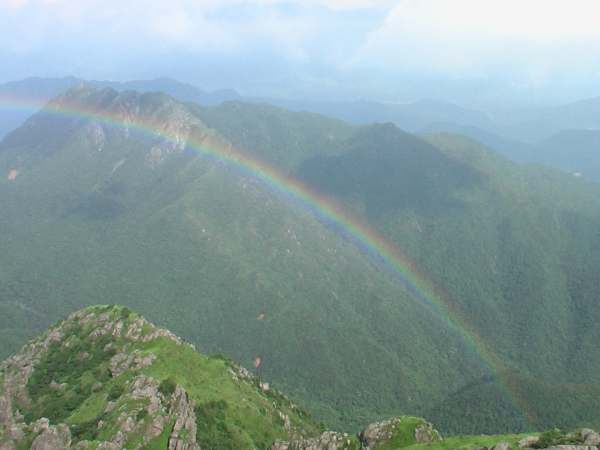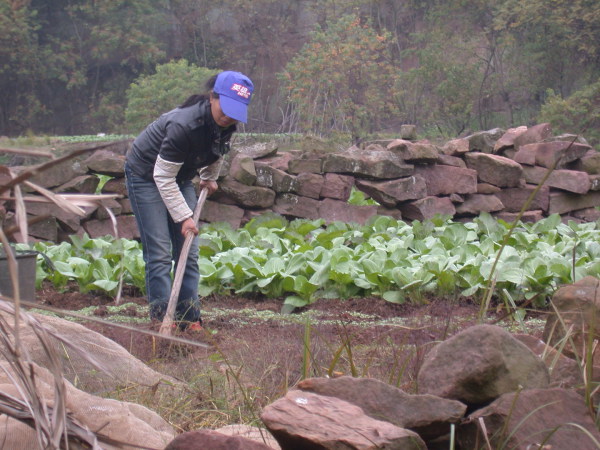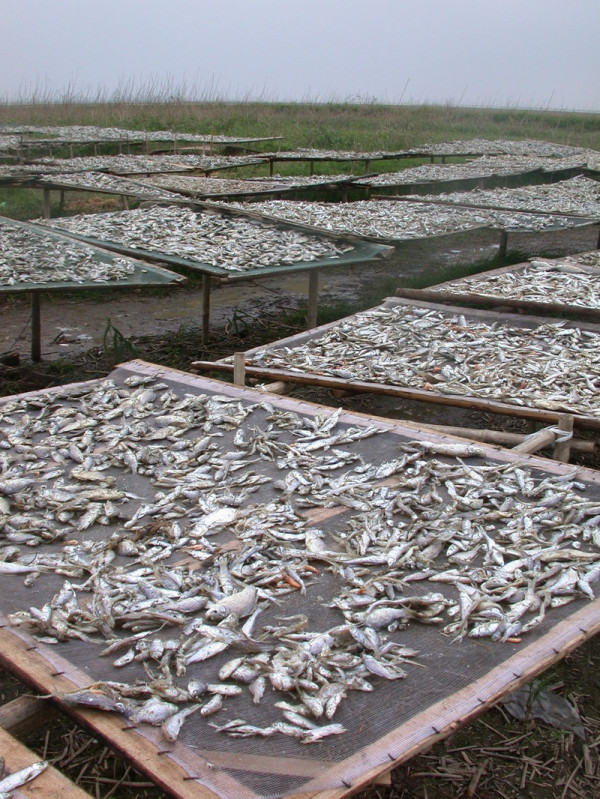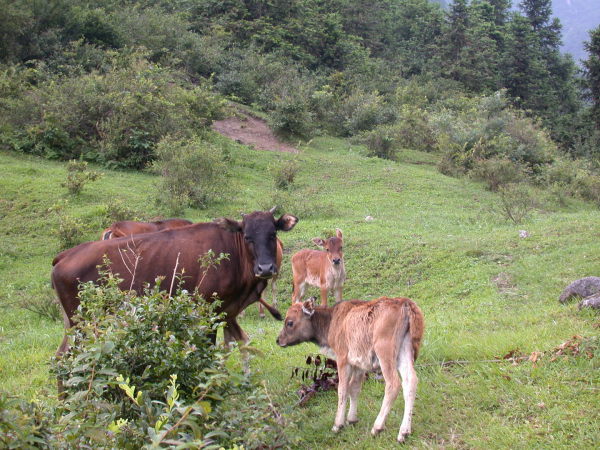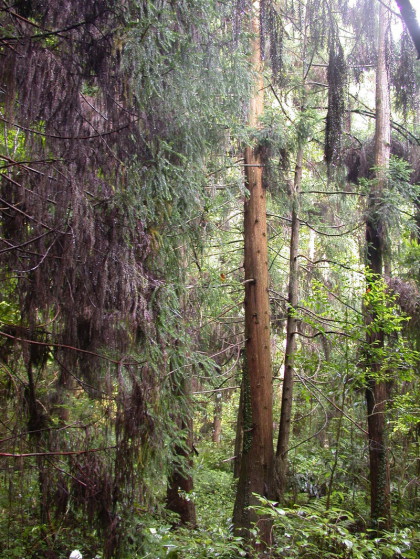Protected areas in Jiangxi Province, China
Pierre L. Ibisch, Stefan Kreft, Christoph Nowicki, Yunsheng Wang, Jingjing Jia, Xiaogang Li, Binhua Hu, Chengkai Liao, Peirong Tang, Yongming Zhang
General setting
In China, an early version of MARISCO was delivered as input for the ‘Sino-German Cooperation Platform for the Conservation of Species Rich, High Carbon-Storing Ecosystems’. The main aim of the project was to build capacity in Chinese institutions responsible for applying protection and management strategies for the conservation of high carbon-storing ecosystems and their biodiversity, thus creating a win-win solution for both biodiversity protection and the reduction of greenhouse gases emissions to the atmosphere (GIZ 2010). With funding from the International Climate Initiative (ICI) the project started in 2009 and ran for two years with the support of the GIZ on behalf of the German Federal Ministry for the Environment, Nature Conservation and Nuclear Safety (BMU).
Box 1: Jiangxi Province
Jiangxi Province is located in the southeast of China and covers 166,900 km2 (Statistics Department of Jiangxi Province 2006). The region extends over a wide altitudinal range with the highest point recorded at 2,157.7m. To the east, south and west of the province the landscape is dominated by mountains with much of the watershed ending up in the Jiangxi catchment as rivers and lakes, dominated by Poyang Lake. The five largest rivers discharge into Poyang Lake, the largest freshwater body in China. Poyang Lake is located just to the south of Yangtze River, which forms the northern provincial border (GIZ 2010). Jiangxi falls within the humid subtropical monsoon climate region and has four seasons. The average monthly temperature is 16.2-19.7° C, and the average rainfall is 1400-1900 mm/yr. The favourable environmental conditions support a diversity of ecosystems and habitats, which are broadly classified into mountains that make up 36% of the land cover; highlands about 42%; flatlands 22%; and wetland around 7% (GIZ 2010). Evidence suggests that during the last ice age the province served as a glacial refuge for many species, including several endemics (Wang et al. 2009). In fact, the region forms part of a more extensive mountain massive, the Nanling mountains, which belong to the seven most endemism-rich regions of China (Tang et al. 2006).
Jiangxi has a subtropical climate with pronounced differences between summer (average temperatures in July up to >30°C) and winter (average temperatures in January normally above 0°C). Annual precipitation is 1200 to 1900 mm and is related mainly to the Asian summer monsoon. Climate change patterns have been observed all over China and show similar trends to many other parts of the world. The minimum temperature has increased in the second half of the 20th century (Zhai et al. 1999) with warming especially noticeable in wintertime (Zhang et al. 2008). The growing season in the temperate regions has extended (Chen et al. 2005), and rainfall patterns have shown a trend towards extreme precipitation events. Whilst the number of above average rain days is decreasing, the amount of precipitation per rain day is increasing (Zhai et al. 1999). Changes to the precipitation pattern since the mid-1980s have been attributed mainly to the evolution of the monsoon system. As a result, the Yangtze River has experienced frequent flooding whilst the region has also undergone periods of drought, which has resulted in significant economic losses (Qian & Zhu 2001). Specifically, in the middle and lower Yangtze reaches, precipitation extremes are becoming more concentrated in the month of June with the highest frequency of extremes, and an increasing probability of flooding (Su et al. 2009). Changes in weather patterns are impacting on terrestrial ecosystems in China, in particular, the areas of subtropical wet forest (Yue et al. 2005). In southeastern China both temperature and precipitation have gone up in recent decades. This change in weather pattern has resulted in the appearance since the 1970s of the tropical moist forest. The centre of this ecosystem has shifted northeast from Hainan province to Guangdong province (Yue et al. 2005).
The government agencies of Jiangxi Province selected three protected areas, Jiu Lian Shan National Nature Reserve, Nan Feng Mian Provincial Nature Reserve, and Poyang Lake Nanji Wetland National Nature Reserve, to include in the MARISCO conservation planning workshop. These three sites were considered to be most representative of the region’s landscape and appropriate examples of protected area management. (Boxes 1-3).
Box 2: Poyang Lake Nanji Wetland National Nature Reserve
It is located in the north of Jiangxi Province, close to the capital Nanchang, between Ganjiang estuary and Poyang Lake, and forming part of Poyang Lake. The reserve’s kidney-like shape covers 33,300 ha and embraces an estuary freshwater ecosystem, from which the whole area is flooded for 3 to 6 months in summer. In autumn and winter, after the floods recede, the exposed lake bed landscape is diverse: large mud floods and grass islands (Carex spp.) a mosaic of river branches, and seasonal lakes cover the protected area. The reserve is home to numerous fish species, dominated by populations of black carp (Mylopharyngodon piceus) and grass carp (Ctenopharyngodon idella). Other important conservation species include a variety of birds, in particular, migratory birds such as oriental white stork (Ciconia boyciana) and siberian crane (Grus leucogeranus). Both birds are highly threatened and depend on the area as a globally important winter resting and feeding site (BirdLife International 2013). Apart from its relevance for species conservation, the hydrological services of the region are also crucial for both local villages and wider communities inhabiting the lower stretches of the Yangtze River.
The conservation status of the nature reserve was raised to the national protected area categories in 2008. Half of the staff has yet to be recruited. Current conservation status can still be seen as good, but it is threatened by proposals to construct dams. Other threats come from the rapid growth in the local population and the demands this puts on natural resources.
Box 2: Nan Feng Mian Communal Protected Area
The reserve lies in the southwest of Jiangxi Province, Suichuan County, directly bordering Hunan Province. It was founded in 2002 and is managed by a staff of about 10 experts from different departments of the county forestry administration. The protected area is linear shaped and covers 4205 ha. Its altitudinal limits extend from 600 to 2,120.4m.a.s.l. The dominant vegetation is subtropical foothill to montane evergreen broadleaved forest. It is also the source for the main rivers in the region.
The nature of the mountain landscape creates conditions that result in several species with fragmented populations (Ziyuan Fir Abies ziyuanensis, Fujian Cypress Fokienia hodginsii, clouded leopard Neofelis nebulosa, cabot’s tragopan Tragopan caboti, chinese pangolin Manis pentadactyla and tibetan macaque Macaca thibetana) (pers. comm. by staff members). The reserve is an important staging-post in the flight-path for migrating birds travelling to the tropics.
About half of the forest within the reserve remains undisturbed or only lightly impacted by human activities. The reserve is virtually uninhabited by people, and the population density in the larger area is relatively low and still decreasing. To the east of the reserve, human settlements and agricultural activities dominate, whilst the remaining surrounding landscape is covered in forest. Important protected areas close by are Jingangshan National Reserve and Bamianshan National Reserve.
Box 3: Jiu Lian Shan Mountain National Nature Reserve
It is located on the border between Guangdong and Jiangxi Provinces, in the Nanling mountains. The area, managed by 50 staff members, was designated as a natural forest protected area in 1975, and then later was upgraded to a provincial protected area in 1981, followed by a final “redesignation” to a national protected area in 2003. It covers 13,412 ha and extends 17.5 km long from south to north and 15 km wide from east to west; the highest peak is the Huangniushi (1434 m).
The core zone is characterised by very well-conserved subtropical evergreen broadleaved forests typical for the Nanling mountains within the Jian Nan ecoregion. The forest is richly structured and diverse in species (144 spermatophyte families including 379 genera and 647 species, Jian et al. 2008): Conifers are found in the emergent layer whilst the main closed canopy is made up of a diverse mixture of broadleaved Fagaceae, Lauraceae, Magnoliaceae and others species; and in the sub-canopy Rhododendron spp. are especially prominent. The tree flora of the species–rich forest alone illustrates the special biogeographical situation of the area; these are mostly species that occur in southeastern China and adjacent tropical countries. Several species are of conservation importance (e.g. Bretschneidera sinensis: globally endangered and under Class I National Protection in China; Kadoorie Farm and Botanic Garden 2003). The ratio of the tropical and subtropical to temperate spermatophyte genera has been recorded as 100:63.9 (Jian et al. 2008). In secondary forests as well as plantations Pinus massoniana is a common species. Basic inventories of vertebrates and some invertebrate taxa exist. Large carnivores such as wolf and tiger have gone extinct (Kadoorie Farm and Botanic Garden 2003); clouded leopards have been rarely sighted, and by local people only. Cabot’s tragopan (Tragopan caboti) and the white-eared night heron (Gorsachius magnificus) represent the most special bird species of the site and the area has been classified as Important Bird Area (BirdLife International 2009). Several possibly endemic insect species have been recorded in the protected area only (e.g., Xistra jiulianshanensis, Orthoptera).
The reserve is located relatively far away from rapidly growing development centres and there appears to be little sign of human-induced changes to the biodiversity. In recent times the local population in villages and small towns has declined as individuals have chosen to live in the more urbanised region of Jiangxi province. New development activities such as tourism and organic farming do not pose imminent threats to biodiversity. The protected area is not large, but connectivity with neighbouring areas is good, and in places, improving (thanks to afforestation and restoration activities).
The staff members have perceived climate change in the form of rising temperatures, changing seasonality (droughts) and extreme precipitation events becoming more frequent. In 2008, a cold front of a severity unrecorded to date caused physical damage to trees as a result of heavy snow and ice. This unprecedented snow disaster in January 2008 brought serious human and economic losses in many parts of China. It is thought that abnormal circulations at high latitudes were the cause of the extreme weather event (Hui 2009).
Workshops and work flow
In the lead-up to the workshop, a series of meetings were held between various officials and scientists from China and Germany to present the latest evidence for climate change in China and to discuss current strategies employed to adapt to and mitigate problems of rapid environmental change. During this process, both conservation managers and science consultants were invited to present their views on the perceived threats imposed on protected areas by problems linked to climate change.
The workshop participants were mainly representatives of the protected area staff, including directors, scientists and students. Introductory lectures on climate change, vulnerability and adaptation were given and discussed in plenary before each group work unit. At the end of each workshop day the plenary talk also provided opportunities to summarise the findings and encourage feedback from the participants.
First working period
The first workshop (‘Vulnerability Assessment Workshop’) involved dividing the participants up into working groups and setting them the task of producing a complex situation analysis for all three protected areas. All workshops were run with the aid of interpreters, with additional help provided by German-speaking Chinese GIZ collaborators. In the beginning, there were some doubts expressed among a small number of participants whether climate change had any significant relevance to protected area management. This was in spite of the case of the Jiu Lian Shan Reserve, where the experience of an extreme weather event some years ago had produced excessive snow and glaze (Box 3). Each team concentrated on just one conservation target. At the end of the first workshop a mid-term report was produced, detailing the method used and the outcomes of the situation analysis. Furnished with this information, the participants would be able to complete the process for all remaining conservation targets in a second workshop facilitated by GIZ staff.
Second working period
The second stage of the MARISCO project began with preparatory documents for the third workshop. The aim of this exercise was to work with the results of the vulnerability analyses of the two foregoing workshops, and to construct a climate-change inclusive, adaptive conservation management strategy for each of the three sites. As part of the exercise, the consultancy unit set off with excursions to Jiu Lian Shan, Nan Feng Mian Reserves and neighbouring areas, and the Poyang Lake Nanji Wetland National Nature Reserve.
Results
The results produced for the three reserves shared a number of characteristics, issues and problems. Included amongst these were responses to questions relating to non-regret options, such as the identified necessity to improve collaboration with neighbouring protected areas, or the need to enhance the visibility of the site and its conservation work. Obvious physical and geographical differences between the sites produced corresponding distinctions in most factors that made up the vulnerability assessment. In the cases of Nanji and Jiu Lian Shan reserves, the conservation focus was on wetlands and forests respectively, whilst for Nan Feng Mian the most important consideration was the status of priority species.
In the last case, a species focus was taken for strategic reasons, namely, to raise the administrative status of this reserve from communal to provincial level. The plight and imminent threat from impacts of climate change to the threatened population of the Ziyuan Fir (Abies ziyuanensis; Earle 2007), which survives as relict stands just below the highest peak in the reserve is a good example of the specific concerns for certain species. The situation for this particular species is all the more urgent because of its absence from the IUCN data base despite its listing as ‘critically endangered’ (Farjon et al. 2012).
The main future threats highlighted by the team representing Jiu Lian Shan reserve were increases in fire risk; prevalence of pests and pathogens; and decreasing water quality. Recommendations made for conservation action included the monitoring of the quality of the water, a change in silvicultural practices and the development of a fire risk management system. In the course of the discussion, an overarching strategy emerged that could have a great impact on the reduction of various vulnerabilities: To propose to neighbouring protected areas the development of a regional cooperative and inter-provincial ‘mega-reserve’, which could help reduce the vulnerability of the three reserves in their current isolated state. A more integrated planning strategy between the three reserves will contribute to the reduction of institutional weakness that currently exists because of lack of publicity, international recognition and funding. The feasibility evaluation for the different strategies encouraged further discussion amongst the teams about the possible problems that might arise with the development of tourism.
In Nanji Reserve, most of the problems identified by the team related to water, in particular a decrease in lake water volume. Part of the problem is geographical, as only a minimal part of the water catchment is inside the protected area. The team for this reserve has proposed two possible solutions to the problem. One idea is to extend the area of influence and/or cooperate more closely with the other protected area at the lake. The second proposal is to adjust the existing level of influence of the protected area to correspond with changes in seasonal levels of the lake and the availability of water for the local communities. The problem with this idea is the lack of public support for the protected area amongst local communities and weak regulatory powers over local land use practices. The obvious solution lies in communicating this tension to authorities on different governmental levels, and negotiating for more administrative power as well as compensation payments for those local communities that depend heavily on the lake and its resources (e.g. fish).
Concerning institutional matters, very different vulnerabilities emerged from the three sites. Jiu Lian Shan is protected at national level and has had a relatively large, well-integrated administration team in command of operations for many years. On the other hand, Nanji and Nan Feng Mian reserves are rather new and still working on establishing functional administrations.
Outcomes and conclusions
General issues
The style of open participatory working and the on-going visualisation of workshop results was initially unfamiliar to the participants although once familiarised, they appreciated its importance in achieving the aims of the project. Similarly, the systemic analysis of threats and contributing factors, which was considered by most participants to be a valuable exercise. Unsurprisingly, continual participation and completion of the whole exercise by individuals led to better results. In all three cases, the workshops were run in close proximity to the work place of the participants and yet the full attendance by all participants was sporadic. The continued presence of staff from GIZ provided much needed support in maintaining the smooth operations of the workshop activities. It also helped proceedings greatly to have additional resources made available by GIZ to management staff during periods when external consultants were unavailable. The protected area teams agreed that the systematic and systemic approach applied to the three protected areas provided totally new insights into management needs, and also facilitated a new type of strategy-building. The exercise presented management staff with opportunities to design protected area management strategies that were both more ‘conscious’ (elaborated transparently) and ‘logical’ (addressing problems adequately) than anything else that had existing previously.
The method worked well and led to the elaboration of a series of sub-products that could be used in the course of strategy formulation. The teams embraced the principles of adaptive management and could see the merits of a ‘working progress’ approach to decision-making that encouraged a reviewing process. For instance, the process of revisiting targets in the Jiu Lian Shan reserve showed that, whenever the vulnerability analyses had facilitated new insights about problems and priorities, it was regarded useful to further adapt the target selection as a priority consideration in the formulation of goals.
Regardless of the underlying basis to MARISCO, which is to be confident about working with partial knowledge the team continued to struggle with the idea of making decisions in the absence of firm evidence.
Nan Feng Mian Communal Protected Area: “Knowledge gaps cause mistakes in the work, sometimes you do not know how to start with solving a problem. Normally, we do not decide before we do not have sufficient information.”
Jiu Lian Shan Reserve: “Knowledge gaps often cause wrong assessments or blind ideas regarding changes, and this is problematic for decision-making in sustainable development. Normally we collect huge quantities of basic information and carefully balance the views of the various actors before we make decisions. But with technical knowledge lacking, we have the wrong information, and our decisions fail in practice. We very much would like to fill some knowledge gaps regarding climate change, but also develop a profound understanding of risk management and modelling for management projections, as well as statistical analyses.”
Systemic vulnerability and risk analysis
The process of producing a semi-quantitative assessment of the different vulnerabilities for the protected areas allowed the teams to draw comparisons between the results for each site. The results also encouraged debate about wider-scale conservation objectives.
Staff from Poyang Lake Nanji Wetland National Nature Reserve documented that the perception of climate change itself has changed a lot. “Before we carried out the vulnerability analysis many collaborators of the reserve did not know anything about climate change – a word that attracts a permanent and high level of international interest.” They thought that extreme weather conditions would only ephemerally harm the protected area that could be compensated for or mitigated by prevention and restoration. At the same time it was felt that impacts of climate change on protected areas was likely to be minimal.
Comprehensive evaluation, prioritisation and strategy formulation
It was a positive learning experience to witness participants identify and ultimately acknowledge the various threats and impacts on biodiversity caused by problems of climate change alongside some of the more obvious man-made threats. The MARISCO exercise generated new insights into adaptive management that extended beyond conventional reactive abatements of threats, and helped to move thinking towards more proactive considerations of reducing vulnerability in protected areas. Included in this perception is the realisation that management decisions may be part of the root-causes of conservation problems.
The staff of the Jiu Lian Shan Reserve stated that “the work with GIZ caused relatively large changes in our attitude towards climate change. Before, our understanding of climate-change related vulnerability of the protected area was rather restricted and we took into account only climate-change-induced impacts of extreme weather on the ecosystem, but we forgot the importance of the humans in increasing the vulnerability. We have to improve the capacity of the ecosystem to cope with the climate change, and this also implies work, which goes beyond the boundaries of the protected area. We strive for enlarging the area, try to coordinate the protection efforts with other protected areas in the vicinities and we call the government to conserve the ecosystems.
For conservation sites it is required to develop a sense of urgency. Preventive measures must be implemented, not only to solve current problems, but also be responsible for future developments, actively carrying out the work of risk projection and prevention, also related to climate change”.
It became apparent that the strategies developed during the Jiangxi exercises had the potential to make a significant difference to conventional management approaches applied elsewhere. The team responsible for Jiu Lian Shan Reserve initially started the exercise with the idea that the conservation situation actually was improving because local people were moving to urban centres. However, in the course of a more systemic and dynamic reflection new threats were identified that were related to the potential use of newly arising property rights. In the beginning, it was assumed that (uncertain) climate change-induced threats could not be confronted by protected area management. Finally, a more risk management-oriented approach built into the strategy gave greater insight into potential problems that otherwise may not have surfaced. For instance, it was agreed the fire-management system should be improved. In the same vein, the reflections about climate change and potential range shifts of species from more southern regions into the protected area made managers of the Jiu Lian Shan reserve even more conscious of their responsibility to maintain the very good conservation status of the ecosystems even outside of the protected area. The integration of climate change into protected area management triggered the willingness to think bigger – both spatially and strategically.
Jiu Lian Shan Reserve: “It is easy to understand it, to implement it, and it can be accepted by different participants. It effectively combines ideas allowing a discussion, conclusion and finally a joint consensus. The discussion and data analyses stimulate a more exact and effective collection of information concerning the protected area, and it helps administration to make better decisions. It is a good assessment method that would also be useful for other sites around the country. Sometimes we communicate with other areas about the method, e.g. with the Hunan Wuyunjie Reserve, and we have achieved a good result. We hope to have further exchange and cooperation”.
References
BirdLife International. 2009. Directory of Important Bird Areas in China (Mainland): Key Sites for Conservation. Cambridge, UK: BirdLife International (English language edition).
BirdLife International (2013): Important Bird Areas factsheet: Poyang Hu wetlands. http://www.birdlife.org/datazone/sitefactsheet.php?id=15658 last visit 19/03/2013.
Chen, Y., G. Gao, G.-Y. Ren, Y.-M. Lia. 2005. Spatial and temporal variation of precipitation over ten major river basins in China between 1956 and 2000. Journal of Natural Resources, f20. 637-643.
Farjon, A., J.-Y. Li, N. Li, Y. Li, G. Carter, T. Katsuki, W. Liao, D. Luscombe, H.-N. Qin, L.-B. Rao, K. Rushforth, Y. Yang, S. Yu, Q. Xiang, and D. Zhang. 2011. Abies ziyuanensis. In: IUCN 2012. IUCN Red List of Threatened Species. Version 2012.2. www.iucnredlist.org. Downloaded on 13 March 2013.
Earle, C.J., 2007. Gymnosperm Database, online (copyright 2006). http://www.conifers.org/pi/Abies_ziyuanensis.php. Downloaded on 13 March 2013.
GIZ (Deutsche Gesellschaft für Technische Zusammenarbeit) & BMU (Federal Ministry for the Environment, Nature Conservation and Nuclear Safety) (2010): Sino-German Cooperation Platform for the Conservation of Species Rich, Highly Carbon-Storing Ecosystems. http://www.biodiversity-climatechange.org/, last visit 19/03/2013.
Hui, G. 2009. China's snow disaster in 2008, who is the principal player? International Journal of Climatology, 29 (14), 2191-2196.
Jian, M., Q. Liu, P. Tang, Y. Liang (2008): Floristic analysis of the evergreen broad-leaved forest community from Jiulianshan National
Nature Reserve in Jiangxi Province, China
Pages 416-423. Frontiers of Forestry in China 4: 416-423.
Kadoorie Farm and Botanic Garden. 2003. Report of a Rapid Biodiversity Assessment at Nanling National Nature Reserve, Northwest Guangdong, China, June-July 2000. South China Forest. Biodiversity Survey Report Series 29. KFBG, Hong Kong SAR, ii + 33.
Su, B., B. Xiao, D. Zhu and T. Jiang. 2005. Trends in frequency of precipitation extremes in the Yangtze River basin, China: 1960-2003 / Tendances d'évolution de la fréquence des precipitations extrêmes entre 1960 et 2003 dans le bassin versant du Fleuve Yangtze (Chine), Hydrological Sciences Journal, 50: 1-492.
Tang, Z., Wang, Z., Zheng, C. & Fang, J. (2006) Biodiversity in China’s mountains. Frontiers in Ecology and the Environment 4: 347–352.
Wang, J., Gao, P., Kang, M., Lowe, A.J., Huang, H, (2009): Refugia within refugia: the case study of a canopy tree (Eurycorymbus cavaleriei) in subtropical China. Journal of Biogeography 36: 2156–2164.
Yue, Tian Xiang, Ze Meng Fan and Ji Yuan Liu. 2005. Changes of major terrestrial ecosystems in China since 1960. Global and Planetary Change, 48: 287-302.
Zhai, Panmao, Anjian Sun, Fumin Ren, Xiaonin Liu, Bo Gao and Quiang Zang. 1999. Changes of climate extremes in China. Climate Change 42: 203-218.
Zhang, Q., C.-Y. Xu, Z. Zhang, G. Ren, Y. D. Chen. 2008. Climate change or variability? The case of Yellow river as indicated by extreme maximum and minimum air temperature during 1960–2004. Theoretical and Applied Climatology 93: 35-43.
Acknowledgements
We would like to thank the GIZ, in particular Eva Axthelm and Stephan Bundscherer, as well as Susanne Lehmann (German Federal Agency for Nature Conservation - BfN), for inviting us to participate in their project and for the always excellent cooperation. We feel deepest gratitude to Jingjing Jia and Yunsheng Wang (GIZ) relates for their enthusiastic support through the whole project and especially on the workshops. Their warmest thanks also go to all the participants of the workshops, whose knowledge, interest, discipline and humour carried the process through moments of low oxygen and continued lack of exposure to sunlight.


